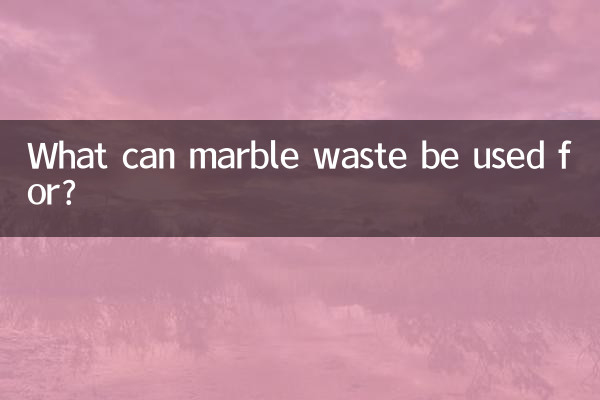What can marble waste be used for? Explore innovative reuse of waste
In recent years, with the improvement of environmental awareness and the increasing shortage of resources, how to efficiently utilize industrial waste has become the focus of social attention. Marble waste, as a by-product in the stone processing process, has long been regarded as waste, but its potential value has been seriously underestimated. This article will combine popular topics and hot contents across the network for the past 10 days to explore the innovative uses of marble waste, and display its application scenarios through structured data.
1. Source and characteristics of marble waste

Marble waste mainly comes from stone mining, cutting and polishing processes, including fragments, scraps and powders. These iga>
| Waste type | Percentage | Main ingredients | ||||||||||||||||||
|---|---|---|---|---|---|---|---|---|---|---|---|---|---|---|---|---|---|---|---|---|
| Fragments | 40%-50% | Calcium carbonate, quartz | ||||||||||||||||||
| Scratch material | 30%-40% | Calcium carbonate, a small amount of metal oxide | ||||||||||||||||||
| powder | 10%-20% | Micron-scale calcium carbonate granules |
| Application areas | Specific use | Advantages |
|---|---|---|
| Construction Engineering | Concrete blending | Improve compressive strength |
| Decorative materials | Artificial marble | Reduce costs by 30% |
2.Environmentally friendly materials: Marble powder can adsorb heavy metal ions and is used for wastewater treatment. Recent studies have found that its adsorption efficiency can reach more than 85%.
lias>| Types of pollutants | Adsorption rate | Processing costs |
|---|---|---|
| Lead ion | 88% | Low |
| Cadmium ion | 82% | Low |
3.Art and Design: Scrap materials can be made into sculptures, collages or home accessories. A designer recently created installation art with waste materials and has received more than 100,000 likes on social media.
4.Agricultural Improvement: The powder can adjust the soil pH value, especially suitable for acidic soil improvement. Experimental data show that the average yield per mu has increased by 15%.
3. Hot cases on the Internet
1. An Italian company uses waste to 3D print furniture, and its products are listed on Milan Design Week; 2. A Fujian company in China converts waste into environmentally friendly paint, and consumes more than 10,000 tons of waste annually; 3. The number of views on the topic "Marble Waste DIY" on TikTok has exceeded 200 million times.
4. Future trends and challenges
Despite the mature technology, the utilization rate of marble waste is still less than 30%. The main bottlenecks are: - High transportation costs; - Lack of standardized processing processes; - Low market awareness. Experts suggest breaking through bottlenecks through policy subsidies and cooperation between industry, academia and research.
Conclusion: The transformation of marble waste from "environmental burden" to "urban minerals" reflects the huge potential of the circular economy. With technological innovation, its value chain will continue to extend.

check the details

check the details